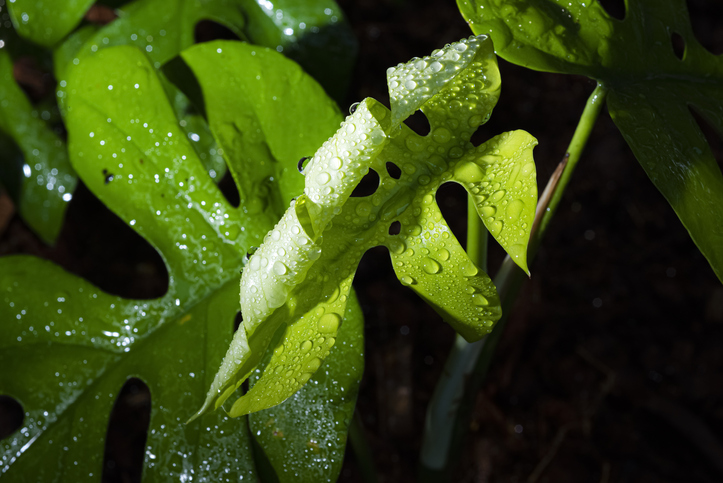This article discusses the similarities and differences between the Monstera and Rhaphidophora, including their classification, size, foliage, care guidelines, and more.
Monstera Minima
The Monstera genus is a popular indoor plant native to the tropical regions of Central and South America.
The genus Monstera is part of the Araceae family and the Juss subfamily. It consists of 48 species, with the most popular ones being Monstera deliciosa, Monstera siltepecana, Monstera esqueleto, Monstera obliqua, and Monstera adansonii.
The genus got its name from the Latin word ‘Monstrum,’ which means ‘Monster’ due to its abnormally large leaves and fenestrations. Hence, the Monstera minima translate loosely to ‘little monster.’
The mini Monstera is an evergreen vining plant closely related to Monstera deliciosa and would be difficult to tell apart from a true Monstera deliciosa if not for their size.
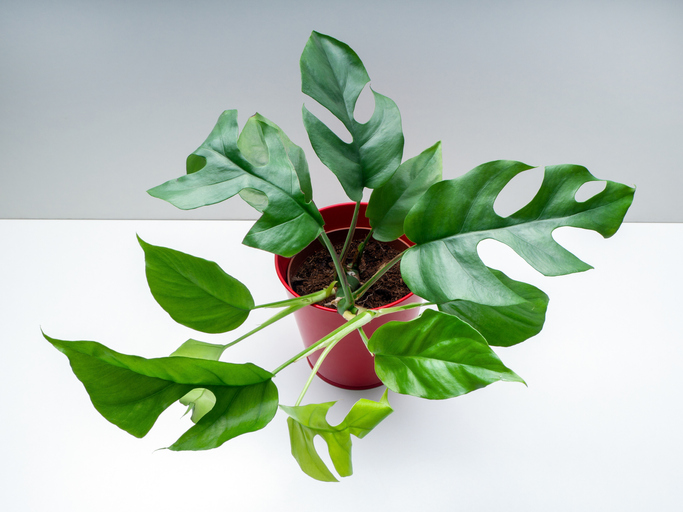
Rhaphidophora Tetrasperma
The Rhaphidophora tetrasperma is part of the same Araceae and subfamily Arum, the same as the Monstera. However, they belong to the genus Rhaphidophora, a flowering plant specie.
The Rhaphidophora is native to the islands of Southern Thailand and Malaysia and is often mistaken for other plants, including the Monstera deliciosa and Philodendron species.
The Rhaphidophora gets its name by combining the Greek word ‘rhaphis,’ which means ‘needle,’ and the Greek word ‘phoreus,’ which means ‘bearer.’
The name Tetrasperma means that the plant is four seeds.
Similarities
The Rhaphidophora is often confused with a miniature deliciosa plant due to its similar characteristics.
These characteristics often make it difficult for a plant lover to differentiate between them. Some of these similarities are mentioned below.
Root System
The Rhaphidophora tetrasperma and deliciosa have aerial roots that grow upwards and anchor the plant to trees as they climb towards sunlight.
These adventitious aerial roots are one of the main reasons the two plants are challenging to differentiate.
These roots are responsible for the epiphytic characteristics of the aroid family and absorb water and nutrients from the air.
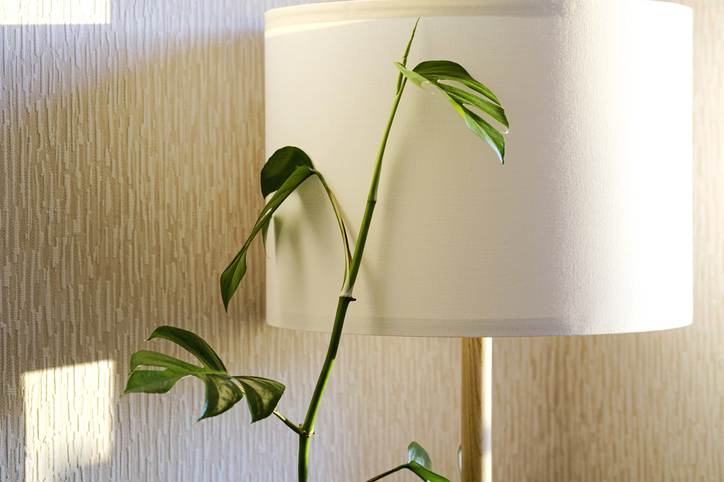
Leaf Structure and Leaf Shape
Although size is significantly different between the Rhaphidophora tetrasperma and Monstera deliciosa, their leaf shape is strikingly similar.
Both these plants share heart-shaped leaves that are larger in width than in length, and the leaf blades curve towards a vortex at the end.
It is difficult to differentiate the two plants based on their leaf structure alone.
Toxicity
Both these plants are toxic for humans and pets. This is because the aroid plants contain calcium oxalate crystals that, if ingested, can cause stomach aches, diarrhea, vomiting, and nausea.
The sap of these plants can cause eye, skin, throat, and mouth irritation if it comes in contact.
In such cases, quickly wash the affected area with water, and if you suspect that you have ingested the sap of the plant, consult a doctor.
Common Pests
Rhaphidophora tetrasperma and Monstera deliciosa are affected by common invaders that feed on these plants and lead to their death.
A common pest Rhaphidophora tetrasperma and deliciosa face are the spider mites. Other pests include aphids and mealybugs.
To inspect whether your deliciosa and Rhaphidophora tetrasperma are infected, check the soil, roots, stem, and leaves of the plants. If you see pests or parts of the plant turning black, your plant might be infested.
However, it is nothing to worry about. You can treat the two plants using pesticide spray or soap and wash them gently.
Common Diseases | Root Rot
Root Rot is a common disease found in both aroids. Root rot is caused by a fungal infection that causes the degradation of the adhering roots and eventually leads to the plant’s death.
Root rot occurs due to overwatering of the plant. This can happen if you overwater the plant, the pot does not have a drainage hole, or if the soil or pot is retaining too much water.
You can treat root rot by separating the infected plant from the rest so as not to spread the disease and by cutting off the dead infected roots. You can wash the aerial root that is still alive using antifungal soap.
An indication of root rot is yellow leaves, or the soil releases a pungent smell.
Care Conditions
The Rhaphidophora tetrasperma and Monstera deliciosa share several similar growth requirements and care conditions when grown as indoor plants.
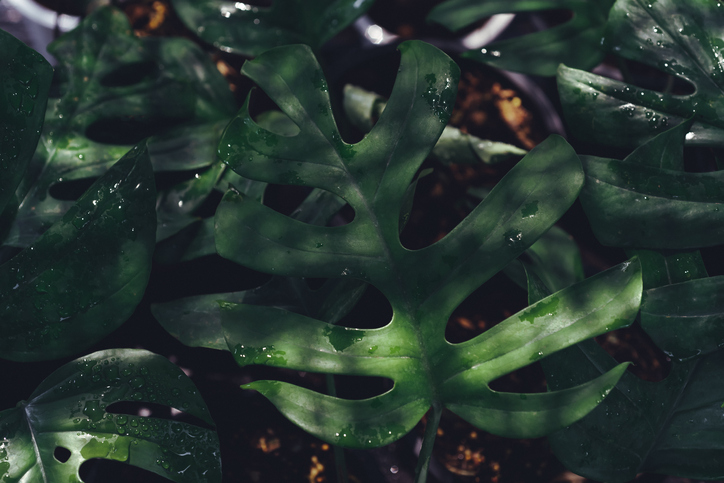
Light
Both these plants grow well in bright indirect light exposure of around six to eight hours. Bright indirect sunlight can increase the growth rate while not causing any problems.
While the deliciosa may require more sunlight to grow due to their size, the Rhaphidophora tetrasperma needs a good amount of light due to its fast growth.
If put in direct sun for too long, the leaves of the plants will start to burn and turn brown. However, too little light can also harm the plant’s growth. This is why it is best to put these plants in a room with a south-facing window that does not receive direct sunlight.
Alternatively, you can also put the plants in a room with an east-facing window. The two Araceae family members can grow well in bright light as long as it’s not that harsh, i.e., in the early hours or the late evening.
Soil
Due to their adventitious roots and hemi-epiphytic characteristics, the Rhaphidophora tetrasperma and deliciosa roots grow in the soil before the plant starts to climb.
Both these plants require a well-aerated potting mix with adequate drainage to prevent constriction while growing.
Potting mix made of coco coil or a peat-based potting mix is an ideal choice for both plants as it is not compact and shows good water retention.
Additionally, a potting mix of pH levels between five to seven containing moist sphagnum moss can be excellent for their growth.
Temperature and Humidity
The deliciosa and Rhaphidophora tetrasperma Monstera are tropical plants accustomed to moderate temperatures and high humidity
levels.
Both these plants grow well at temperatures between 55 to 75 degrees Fahrenheit and high humidity levels of up to 80%.
You can place these plants near the bathroom or in the kitchen, where the temperatures are known to be moderately high.
You can maintain the humidity levels by misting the Monstera leaves regularly or using a humidifier. Alternatively, you can cluster all of your plants or place a pebble tray underneath the pot.
Pruning
Although the speed at which the two species grow differs, there is no doubt that the two are considered quick growers.
Hence, plant owners often run out of space when they grow these plants indoors.
To avoid such an issue, regularly prune these plants using gardening shears or scissors in their growing period, i.e., summer and spring.
Additionally, you should prune your Monstera and Rhaphidophora if their roots, stems, or leaves are infected.
Carefully cut the stems from the nodes (the slightly brown swollen areas at the base). You can then use these stem cuttings to propagate new plants.
Propagation
Both these plants are propagated similarly through water or soil propagation.
Carefully cut the stems at the node using sterilized scissors, and ensure that at least one leaf is attached to the stem cutting.
Cutting a stem with a few roots already growing out of the node would be best. A node without roots works fine as well.
Place the stem cutting in water and after two or three weeks, once the roots have sprouted, transfer the cutting to the pot. Ensure that the leaf is not submerged in the water.
Alternatively, you can place the stem cutting directly in the soil without putting it in water. Ensure that the node is buried in the soil.
You can propagate the Rhaphidophora plant and the deliciosa if you are interested in selling Monstera.
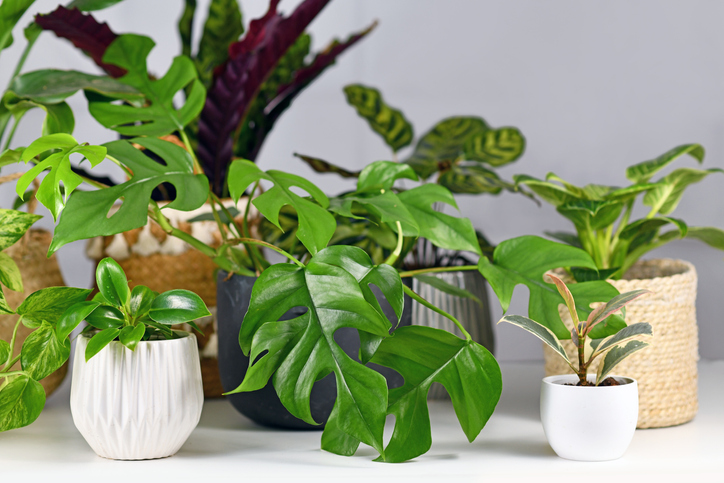
Differences
Despite their numerous similarities, there are many ways to differentiate the Monstera minima Rhaphidophora tetrasperma and the deliciosa.
Some of the most significant differences between the two aroid species are mentioned below.
Foliage
One of the most significant differences between the two Araceae plants is their foliage. Such is the difference in foliage that even a novice plant collector can differentiate between the two.
For one thing, the deliciosa is massive compared to the Rhaphidophora tetrasperma, with the deliciosa leaves alone growing to two feet. In contrast, the entire plant grows more than eight feet tall indoors.
Rhaphidophora’s leaves only grow around one foot, with the entire Rhaphidophora tetrasperma plant growing to around five feet indoors.
Additionally, the color and texture of the two species set them apart. While the Monstera has dark green leaves with a glossy texture, the Rhaphidophora has light-green leaves with a dull texture.

Fenestrations
Fenestrations refer to the leaf holes that the Monstera species is known for. The species’ split leaves are an adaptive feature to survive the strong winds in tropical forests.
While both plants share this feature, there are distinct differences in leaf appearance.
The Monstera leaf holes are elliptical and circular, while the Rhaphidophora leaf holes are more straight. Additionally, the deliciosa has leaves in the middle of the leaf that stretch to the leaf blade, while these holes are absent in the Rhaphidophora tetrasperma.
Usually, the Monstera species are difficult to tell apart as juvenile plants. However, that is not the case with Monstera minima.
A juvenile Rhaphidophora tetrasperma already develops holes in the young leaves, while the Monstera deliciosa only does show once it becomes a mature plant.
Flowering and Fruits
Monstera plants rarely flower indoors, and it’s even rare for them to grow fruits indoors, so you might not be able to flower Monstera yourself.
However, the Monstera deliciosa can flower for around two to three years in their natural habitat.
The flowers create edible fruit that resembles a grape after a year of flowering that tastes between a banana and a pineapple.
On the other hand, the Rhaphidophora tetrasperma rarely ever flowers and does not produce edible fruit.
Growth Rate
Under the right conditions, both these species are considered quick growers, but there is an inherent difference in the growth rate.
The difference in the growth habit of the Rhaphidophora tetrasperma vs. the deliciosa allows us to tell the two apart.
Rhaphidophora tetrasperma tends to grow quicker and develop faster than the Monstera deliciosa and is considered the quickest proliferator amongst the Aroid plants.
Growth Requirement
Although the two share many similar care conditions when grown indoors, there are specific differences in their growth requirements.
Watering
As mentioned, the Rhaphidophora tetrasperma is a faster grower than the deliciosa. Hence, it requires more frequent watering than the Monstera deliciosa.
Since they grow quickly, the Rhaphidophora tetrasperma leaves absorb more water, and the soil tends to get dry quickly.
Generally, water the plant once every five to seven days in the summer and once a month in the winter.
Water the Monstera leaves once every two weeks in the summer and once every two months in the winter.
However, the watering requirements of these species are relative. A good way of knowing when to water the plant is to check if the top two inches of the soil are dry with your finger.
Fertilizers
While both these plants do not require fertilizers, they can help to speed up growth and cause them to produce thicker stems.
The Monstera deliciosa does well with a balanced liquid fertilizer with equal parts of nitrogen, phosphorus, and potassium.
The mini Monstera plant does well with organic fertilizers such as neem oil since strong chemical fertilizers burn the delicate roots.
Fertilize the plants in the growing season of summer to avoid overfeeding.
Repotting
Due to the difference in growth between the two, you must repot them at different times.
Generally, a juvenile deliciosa needs to be repotted frequently, but a mature Monstera deliciosa needs to be repotted once every two to three years.
A mini Monstera needs more frequent repotting, at least once a year.
A good way of knowing when to report the Monstera and Rhaphidophora is to check if the roots are growing out of the pot from the surface of the drainage holes.
A clay pot is an excellent way to go when choosing a new pot since it’s less costly and has good water retention.

Price
To grow houseplants, you must know what to expect when purchasing them.
To put it simply, the Monstera deliciosa costs more than the mini Monstera, with a mature plant averaging around $20 or more. A variegated deliciosa can cost even more due to its rarity.
You can purchase the Monstera deliciosa at plant nurseries or online at Etsy or Amazon.
The mini Monstera can cost around $10 to $15, and you can purchase the plant online at Etsy or Amazon.
Important to Know
Before purchasing either the Monstera deliciosa or the mini Monstera, check out some essential things about these species.
· Both of these plants share a similar growth habit. The two climbing vines can grow on trees or any structure indoors, including walls, doors, shelves, and a moss pole.
· The Monstera deliciosa is a lovely plant to grow indoors and is loved by plant enthusiasts.
· These plants are infected mainly by pathogenic diseases that can transfer from one to another and need to be separated at the first sign of infection, such as yellow or brown leaves, stunted growth, decomposing roots, etc.
· The Rhaphidophora tetrasperma Monstera can grow to an average of 12 feet.
· The Monstera deliciosa can grow to an average of 15 feet or higher.
· Too much direct sun can burn the plant’s leaves, while too little sun can stunt growth. Avoid putting them in too much sun or too little sun.
· The Monstera deliciosa fruits are edible and nutritious.
· Monstera deliciosa is often called the swiss cheese plant and the split-leaf plant.
· The Rhaphidophora tetrasperma is often called the mini Monstera, split-leaf Philodendron, or mini-split leaf.
· Both these plants grow well in USDA hardiness zones 10 to 12.
· Monstera species was first discovered in 1693 by French botanist Charles Plumier who was also made the Royal botanist of the French king.

Frequently Asked Questions
1. Is Monstera deliciosa rare?
While it is considered one of the most common Monstera species, the Monstera deliciosa is a rare houseplant. It is only found in the tropical forest of Southern Mexico and Panama, with some species in Hawaii.
2. Is mini Monstera rare?
Rhaphidophora tetrasperma is a rare plant that is native to the rainforests of Southern Thailand and Malaysia.
3. Can I use an orchid bark for both these plants?
The mini Monstera and Monstera deliciosa have delicate aerial roots that require well-aerated soil.
Orchid bark is a good potting mix for the very sensitive roots of the two species to provide fertilizing conditions to these epiphytes and has quick draining and moisture retention abilities that keep the soil lightly moist.
4. Is the Rhaphidophora tetrasperma toxic?
The Rhaphidophora plants got their name due to the presence of calcium oxalate crystals, making them toxic to humans and pets.

My name is Daniel Elrod, and I have been houseplant love ever since I was 17. I love how much joy they bring to any room in the home. I’ve always been amazed at how a few pots of flowing leaves can turn a drab and sterile office into an inviting place where people love to work at.

